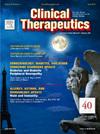抗生素治疗脓毒症引起的急性肾损伤的比较疗效和安全性:一项回顾性队列研究。
IF 3.6
4区 医学
Q2 PHARMACOLOGY & PHARMACY
引用次数: 0
摘要
目的:急性肾损伤(AKI)是脓毒症患者常见且严重的并发症,某些药物可能加重,严重影响发病率和死亡率。本研究旨在评价不同抗生素方案治疗败血症性AKI的比较疗效和安全性。方法:本回顾性队列研究分析了2022年至2024年间因败血症导致AKI的成年患者。患者分为三组:第一组接受β -内酰胺单药治疗(如哌拉西林-他唑巴坦);2组给予非-内酰胺类抗生素治疗(如氟喹诺酮类、大环内酯类);第3组接受联合治疗(如贝他坦加万古霉素治疗MRSA)。收集了人口统计学、临床参数和结果的数据,包括住院死亡率、住院时间和肾功能。结果:共纳入552例患者,各组间基线特征无显著差异。联合治疗组发热时间较短(1.33±0.57天,P = 0.001), 30天死亡率较低,住院时间较短(4.36 = 0.81天,P = 0.001)。血清肌酐水平在所有组中均显著升高(P = 0.005),以联合治疗组最高。氟喹诺酮类药物组AKI发生率为25.3%,β -内酰胺类药物组为15.7%,联合治疗组为18.9%。11.2%的倍他坦患者和16.5%的氟喹诺酮患者需要肾脏替代治疗。意义:本研究强调了脓毒症AKI患者不同抗生素治疗方案在肾脏预后方面的显著差异。虽然联合治疗可以改善感染控制,但也会对肾功能造成风险。临床医生在为脓毒症患者选择抗生素方案时应考虑这些发现,特别是那些先前存在肾脏损害的患者。本文章由计算机程序翻译,如有差异,请以英文原文为准。
Comparative Efficacy and Safety of Antibiotic Regimens in Sepsis-Induced Acute Kidney Injury: A Retrospective Cohort Study
Purpose
Acute kidney injury (AKI) is a prevalent and serious complication in septic patients, potentially exacerbated by certain medications, which significantly affects morbidity and mortality rates. This study aims to evaluate the comparative efficacy and safety of different antibiotic regimens for treating sepsis-induced AKI.
Methods
This retrospective cohort study analyzed adult patients with AKI resulting from sepsis between 2022 and 2024. Patients were divided into three groups: Group 1 received beta-lactam monotherapy (e.g., piperacillin-tazobactam); Group 2 was treated with non-beta-lactam antibiotics (e.g., fluoroquinolones, macrolides); and Group 3 received combination therapy (e.g., betalactam plus vancomycin for MRSA). Data on demographics, clinical parameters, and outcomes—including in-hospital mortality, length of stay, and renal function—were collected.
Findings
A total of 552 patients were included, with no significant differences in baseline characteristics among the groups. The combination therapy group experienced a shorter duration of fever (1.33 ± 0.57 days, P = 0.001), lower 30-day mortality, and shorter ICU stays (4.36 = 0.81 days, P = 0.001). Serum creatinine levels rose significantly across all groups (P = 0.005), with the highest levels observed in the combination therapy group. AKI incidence was 25.3% in fluoroquinolone patients, 15.7% in beta-lactam patients, and 18.9% in the combination therapy group. Renal replacement therapy was required for 11.2% of betalactam and 16.5% of fluoroquinolone patients.
Implications
This study underscores significant differences in renal outcomes associated with various antibiotic regimens in septic patients with AKI. While combination therapy may improve infection control, it also poses risks to renal function. Clinicians should consider these findings when selecting antibiotic regimens for septic patients, particularly those with preexisting renal impairment.
求助全文
通过发布文献求助,成功后即可免费获取论文全文。
去求助
来源期刊

Clinical therapeutics
医学-药学
CiteScore
6.00
自引率
3.10%
发文量
154
审稿时长
9 weeks
期刊介绍:
Clinical Therapeutics provides peer-reviewed, rapid publication of recent developments in drug and other therapies as well as in diagnostics, pharmacoeconomics, health policy, treatment outcomes, and innovations in drug and biologics research. In addition Clinical Therapeutics features updates on specific topics collated by expert Topic Editors. Clinical Therapeutics is read by a large international audience of scientists and clinicians in a variety of research, academic, and clinical practice settings. Articles are indexed by all major biomedical abstracting databases.
 求助内容:
求助内容: 应助结果提醒方式:
应助结果提醒方式:


